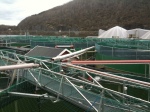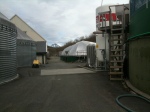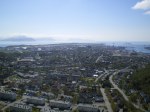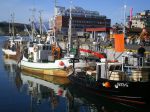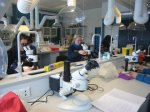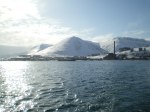First my apologies to everyone who has been habitually checking my blog, only to see that no I haven’t updated. Again. Tales of the past couple weeks will be coming in bits and pieces, undoubtably elaborated by my imagination filling in the gaps of memory.
Spring has sprung in Bodo. Sunrise today was at 5:41 and sunset will be at 20:28. It is amazing how fast the light is coming back! Since Good Friday the weather has been wonderful. All Easter weekend the skies were blue and the snow was melting. We’ve had a couple days of light rain, but at this point it is welcome to help melt the snow of which there is still a good covering.

April 4th
With the good weather, I’ve convinced myself to get my ass back in gear so I can play rugby this summer. There’s an astro-turf ‘football’ pitch a bit down the road that is clear and dry that I’ve been using for fitness work. The scenery on my morning runs is breathtaking.. No, wait. That’s the 3 months of watching too much Norwegian tv. Speaking of which they are introducing TLC in Norway. As if the world needs more Jon and Kate Plus 8 and Say Yes to the Dress.
I am very envious of all the Canadians who spent their Easter in shorts or on the beach.
A long, long while ago Kayla and I vaguely talked about her coming for a visit. A while ago, just a few days before the potential weekend we talked about Kayla and I exchanged messages resembling:
Sam: I’m assuming you aren’t coming this weekend. No worries, it won’t hurt to wait until it is warmer.
Kayla: Hell yes I’m coming this weekend! My flight gets in at uhhh sometime Friday night.
So Kayla came for a visit, it was a blast and the first time we’ve seen each other in a year and the first time we’ve hung out just the two of us in a couple years. We had a busy weekend of experiencing Bodo. On Friday, we got dolled up and went out with my roommates to Vinterball. As Kayla put it, ‘Sammy, I never thought we’d be using the same mirror to put on make-up’.
In the week proceeding Kayla’s visit we got snow almost everyday, it was at least 3 ft deep in most places. This was the first real snow Kayla had seen all winter! So the Saturday saw us get out on skis together for the first time since OFSAA in high school. I think we were wayyy faster back then. It didn’t help that the classic skis I had borrowed were not properly waxed for the conditions.
While we were out on the trail, I decided it would be a good idea to show Kayla the look-out bench so she could take some great photos. We popped off our skis and I took a step off onto the side trail through the woods. And I sunk, and sunk, and sunk. Up to my hips in the snow. Undaunted we proceeded the couple 100 m’s to the look out. We kind of crawled, kind of trudged, kind of swam, but mostly floundered until we reached the lookout. It was exhausting. And of course we did this at the start of our 4 hour ski.
You would have thought we learned our lesson about trudging through the snow, but on Sunday we did it yet again. This time we took a walk along the fjord and the well tracked path turned less and less into a path until we left trudging through a cow pasture in hip deep snow.
Having exhausted our outdoorsyness for the week, we went downtown on Monday to see the sights aka. take idiotic photos and shop. I played ‘the boyfriend’ waiting patiently while Kayla tried on every single hat in the sports store, only to buy one and then go back a couple hours later to buy a second one. And I waited patiently while Kayla debated the merits of different sealskin boots. She did eventually buy a gorgeous pair of boots, of which I’m a little envious.

Bodo Harbour
Norway is actually Canada’s largest market for our seal products, in addition to having a seal harvest of their own (albeit only taking about 7% the seals Canada does). The Norwegian hunt is smaller than our commercial seal harvest and Norwegians as a people are more accepting of the seal hunt as it is seen as a fundamental part of the culture. Seal meat is relatively common place in Norway, as is whale meat from the Norwegian harvest of Minke whales. In 2005, the seal hunt in Norway was opened up to tourists.
In the mean time it seems my Russian roommate has moved out after not seeing her all Easter and we have a new roommate in the other empty room. Unfortunately, the new roommate is much more mature than myself or even the guys. I hope she tolerates us.


